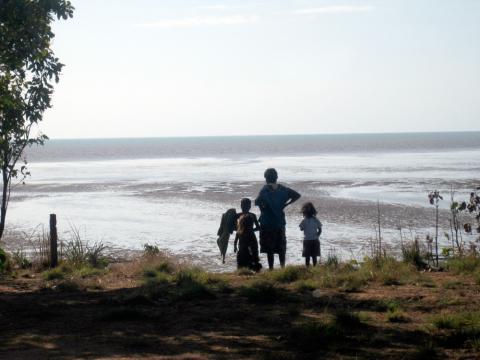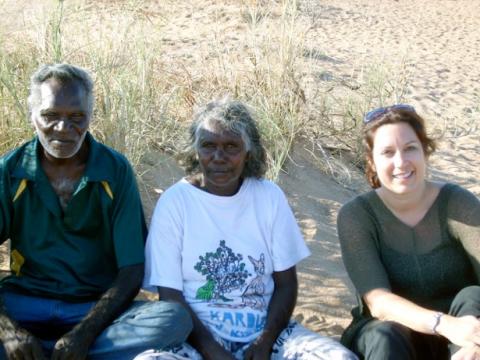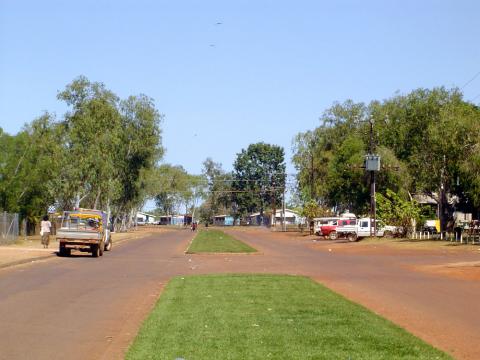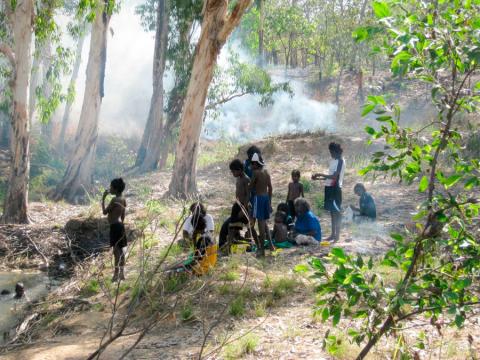Language acquisition of Murrinhpatha (LAMP)
LAMP
Overview
Project title
From little things, big things grow: How children learn a morphologically complex Australian indigenous language
Chief investigators
Professor Rachel Nordlinger, Professor Gillian Wigglesworth, Dr Barbara Kelly, Dr Joe Blythe
Grant type
ARC Discovery Grant (2011-2015)
Summary
This project aims to provide detailed study of the acquisition of Murrinhpatha (Wadeye, NT), based on the language of Murrinhpatha speaking children from 2-6 years. Although much is known about how children acquire languages such as English, there is very little research that examines how children acquire a complex polysynthetic language like Murrinhpatha. The findings from this project will have implications for our understanding of how acquisition processes are created through linguistic complexity, cognitive constraints and social interaction and how these processes differ across children acquiring radically different language types. It will also provide detailed language information for the bilingual school program in Wadeye to ensure that the maintenance of Murrinhpatha is optimally managed in the early school years.
Introduction
Murrinhpatha is a polysynthetic language spoken by a 2500 strong community in community in Wadeye (pron. wha-da-ya as in “Wha’-da-ya think?”) in the north west of the Northern Territory of Australia. It has a very rich morphological system in which a succession of different morphemes are added to word roots to indicate concepts that, in languages like English, would require entire phrases to express. For example, the Murrinhpatha word wurdamnginthadhawiweparlwardagathu means “then the two non-siblings, at least one of whom was female, spoke out in unison.” English-learning children tend to acquire morphological relations after they have acquired some basic grammatical relations. The question then arises as to whether or not children acquiring more morphologically complex languages show the same general developmental sequence; and if so, how is this to be achieved when so much grammatical information is embedded within a single word?
Although much is known about how children acquire isolating languages such as English, there is very little research that examines how children acquire a complex polysynthetic language like Murrinhpatha. The aim of this project is to not just provide a detailed study of the acquisition of Murrinhpatha (although this will be the first comprehensive input and production acquisition study of any non-Pama Nyungan Australian indigenous language) but also to provide detailed language information for the local bilingual program to ensure the maintenance of Murrinhpatha is optimally managed in the early school years. Furthermore, the study of such a typologically unusual language will provide new insights into how acquisition processes are created through linguistic complexity, cognitive constraints and social interaction. We seek to address these aims through the following Research Questions:
- What does the Murrinhpatha that children in Wadeye hear in their daily interactions look like?
- What language are 2-8 year-old children in Wadeye producing in their daily interactions?
- What are the syntactic, morphological and socio-pragmatic features of their communications?
- Can we identify the order of acquisition of grammatical morphemes by pre-school and school-age children and if so, how does this compare to the ordering found in other languages?
- How does the input and acquisition of Murrinhpatha grammatical structures relate cross-linguistically to the acquisition of other structures occurring in spontaneous speech?
- How do cognitive, linguistic and social factors interact in Murrinhpatha-learning children’s development?
Chief investigators
The LAMP project is directed by a cross-disciplinary team of four chief investigators from the University of Melbourne (Gillian Wigglesworth, Rachel Nordlinger, Barbara Kelly and Joe Blythe). To assist in data collection and analysis, several indigenous researchers resident in the Wadeye community will also contribute to the project. Finally, two graduate researchers are employed to run longitudinal studies as well as collecting data for their own PhD projects.
Professor Rachel Nordlinger
Nordlinger has worked extensively in the Wadeye community and is familiar with Murrinhpatha. She is an expert in the grammatical description of Australian indigenous languages (Bilinarra, Wambaya and Murrinhpatha).
Professor Gillian Wigglesworth
Wigglesworth has worked with indigenous children acquiring both Kriol (Tennant Creek and Yakanarra) and Gurindji Kriol (Kalkaringi) and also has expertise in bilingualism as well as English as a second language.
Dr Barbara Kelly
Kelly is an expert in the acquisition of socio-pragmatics and socialisation as well as argument structure. Kelly has investigated children’s early language development and their use of gesture as a means of acquiring argument structure. She has expertise in Tibeto-Burman studies (Sherpa) and in socio-pragmatics.
Graduate researchers
There are two graduate researcher positions associated with this project. The work involves extensive fieldwork (5 trips) over a three-year period and contributes to the collection of cross-sectional data.
Mr Bill Forshaw
Bill will be following six focus children aged 2-6 over a three year period. He will be contributing to the project as well as working on his on doctoral thesis entitled “The acquisition of verbal morphology in Murrinhpatha.”
Ms Lucy Davidson
Publications
Book chapters and conference presentations
- Nordlinger, R. (in press). “Inflection in Murrinh-Patha,” in Baerman, M. (ed.,). Handbook on Inflection. Oxford: Oxford University Press.
- Blythe, J. (2014). “Genesis of the Trinity: The Convergent Evolution of Trirelational Kinterms,” in McConvell, P. and Kelly, P. (eds.,). Skin, Kin and Clan: The Dynamics of Social Categories in Indigenous Australia. Canberra: ANU EPress
- Kelly, B. F. and Nordlinger, R. (2014). “Fieldwork and First Language Acquisition,” in Gawne, L. and Vaughan, J. (eds.,). Selected papers from the 44th Conference of the Australian Linguistic Society, 2013. Melbourne: University of Melbourne. pp. 178-192
- Blythe, J. et al. (2013). “Huh? What? – A first survey in 21 languages,” in Hayashi, M., Raymond, G. and Sidnell, J. (eds.,). Conversational Repair and Human Understanding. New York: Cambridge University Press. pp. 343-380
- Nordlinger, R. (2012). “Number Marking in the Daly Languages (Australia),” in Butt, M. and King, T.H. (eds.,). Proceedings of the LFG12 Conference. Stanford: CSLI Publications. pp. 422-439
- Blythe, J. (2011). “Laughter is the Best Medicine: Roles for Prosody in a Murriny Patha Conversational Narrative,” in Baker, B., Mushin, I., Harvey, M. and Gardner, R. (eds.,). Indigenous Language and Social Identity: Papers in Honour of Michael Walsh. Canberra: Pacific Linguistics. pp. 223-236
Articles
- Dingemanse, M., Blythe, J., and Dirksmeyer, T. (2014). “Formats for Other-Initiation of Repair Across Languages: An Exercise in Pragmatic Typology,” in Studies in Language Vol. 38, No. 1. pp. 5-43
- Kelly, B., Wigglesworth, G., Nordlinger, R. and Blythe, J. (2014) “The Acquisition of Polysynthetic Languages,” in Language and Linguistics Compass Vol.8, No. 2. pp. 51-64
- Blythe, J. (2013). “Preference Organization Driving Structuration: Evidence from Australian Aboriginal Interaction for Pragmatically Motivated Grammaticalization,” in Language Vol. 89, No. 4. pp. 883-919. The research is also explained in layman’s terms on the Preference Organization Driving Structuration website
- Blythe, J. (2012) “From Passing-Gesture to ‘True’ Romance: Kin-Based Teasing in Murriny Patha Conversation,” in Journal of Pragmatics Vol. 44. pp. 508-528. doi:10.1016/j.pragma.2011.11.005
- Nordlinger, R. and Caudal, P. (2012). “The Tense, Aspect and Modality System in Murrinh-Patha,” in Australian Journal of Linguistics Vol. 34, No.1. pp. 73-113
- Nordlinger, R. (2011). “Transitivity in Murrinh-Patha,” in Studies in Language Vol. 35, No.3. pp. 702-734
Presentations
Conference presentations and posters
2014
- Forshaw, W. (2014). “Little Kids Big Paradigms.” Poster presented at the International Association for the Study of Child Language Conference, Amsterdam. July 2014
- Forshaw, W. (2014). “You Can’t Always Get What you Want: Eliciting Verbs From Children Acquiring Murrinh-Patha.” Paper presented at the 13th Australian Languages Workshop, Kioloa. March 2014
- Kelly, B.F., Nordlinger, R. and Wigglesworth, G. (2014). “Input and Acquisition of a Polysynthetic Australian Language.” Poster presented at International Association for the Study of Child Language, Amsterdam. July 2014
- Nordlinger, R. (2014). “Verbless Polysynthesis.” Paper presented at the 13th Australian Languages Workshop, Kioloa, NSW. March 2014
2013
- Blythe, J. (2013). “Formats for Interrogating Another’s Prior Talk: Murrinh-Patha Repair Initiation in Cross-Linguistic Perspective.” Paper presented at Australian Linguistic Society Conference, the University of Melbourne. (2/10/2013)
- Caudal, P., Nordlinger, R. and Seiss, M. (2013). “Complex Predicates in Murrinh-Patha: Towards a Formal and Comparative Approach.” Paper presented at Approaches to Complex Predicates Conference, Paris. May 2013
- Forshaw, W. (2013). “Acquiring ‘Bipartite’ Verbs: Murrinh-Patha ‘Bipartite’ Verb Usage in the Speech of Four Children (2;6-4;5).” Paper presented at the 44th Annual Meeting of the Australian Linguistic Society, Melbourne. October 2013
- Forshaw, W., Nordlinger, R. and Blythe, J. (2013). “Complexity in use: Implications for Learning Murrinh-Patha.” Presented at the 12th Australian Languages Workshop, North Stradbroke Island. 8-10 March 2013
- Kelly, B. and Nordlinger, R. (2013). “Out of the Lab and Into the Field: Fieldwork and Language Acquisition Research.” Paper presented at the 44th Annual Meeting of the Australian Linguistics Society, Melbourne. October 2013
- Kelly, B., Wigglesworth, G. and Nordlinger, R. (2013). “Interactions of Domain Theory and Audience Design in Elucidating Variant Bilingualism Across an Indigenous Australian Aboriginal community.” Paper presented at the International Symposium on Bilingualism, Singapore. June 2013
2012
- Blythe, J. (2012). “A Structural Solution to a Pragmatic Problem: Murrinh-Patha’s Tri-Relational Avoidance Kin Terms.” Paper presented at the Australian Linguistic Society Annual Conference, Perth. 5-7 December 2012
- Blythe, J. (2012). “Murriny Patha’s “Quotative” Avoidance Kinterms.” Paper presented at the Australian Languages Workshop, North Stradbroke Island, Australia. (10/03/2012)
- Blythe, J. (2012). “Preference Organization Driving Structuration: Evidence from Australian Aboriginal Interaction for Pragmatically motivated Grammaticalisation.” Paper presented at the 7th European Australianists at the SOAS Conference, London. (02/04/2012)
- Forshaw, W., Nordlinger R. and Blythe, J. (2012). “Complexity in use: Predictions for Learning Verbs in Murrinh-Patha.” Paper presented at the ALS Conference, UWA, Perth. December 2012
- Forshaw, W. (2012). “Body Part Incorporation in Murrinh-Patha: A Continuum of Structures.” Presented at the 11th Australian Languages Workshop, Stradbroke Island. March 2012
- Nordlinger, R. (2012). “Complex Predicates in Murrinh-Patha: Problems for Analysis.” Paper presented at the ALS Conference, UWA, Perth. December 2012
- Nordlinger, R. (2012). “Number Marking in the Daly.” Invited workshop contribution, LFG Conference, Bali, Indonesia. June 2012
2011
- Blythe, J., Nordlinger, R., Kelly, B. and Wigglesworth, G. (2011). “The Acquisition of Murrinh-Patha.” Paper presented at the Australian Linguistics Society Conference, Canberra. December 2011
- Blythe, J. (with Jacqui Tosi). (2011). “Kanamkek Yile Ngala Museum / Wadeye Aboriginal Languages Centre.” Paper presented at The Life Of Archived Objects And Languages: A Workshop On Language And Material Culture, Leuven, Belgium. (7/5/2011)
- Caudal, P. and Nordlinger, R. (2011). “A Murrinh-Patha View of Counterfactuality and the Irrealis.” Paper presented at the Australian Linguistics Society Conference, Canberra. December 2011
- Nordlinger, R. and Caudal, P. (2011). “Counterfactuality and the Irrealis in Murrinh-Patha.” Paper presented at the Australian Languages Workshop, Stradbroke Island, QLD. March 2011
- Nordlinger, R. (2011). “From Body Parts to Applicatives.” Paper presented at the Association for Linguistic Typology conference, Hong Kong. July 2011
- Seiss, M. and Nordlinger, R. (2011). “An Electronic Dictionary and Translation System for Murrinh-Patha.” Paper presented at EUROCALL 2011, Nottingham. September 2011
Other presentations
- Kelly, Barbara and Davidson, Lucinda (2015). ““I talk... she copy with me” Carer language-learning beliefs in Murrinhpatha.” (3.6Mb pdf) Presentation at ALS, Parramatta.
- Davidson, L. (2014). “Learning to Talk to and About the World: The Acquisition of Reference in Murrinh-Patha.” Presentation at ACLA 2 meeting, Australian National University (ANU), Canberra. January 2014
- Forshaw, W. (2014). “Who is that? What are they doing? Designing a Picture-Based Elicitation Task Targeting Murrinh-Patha Verbs.” Invited presentation given at the January 2014 Aboriginal Child Language Acquisition project, Phase 2 meeting, ANU, Canberra. January 2014
- Blythe, J., Dunn, M., and San Roque, L. (2013). “Interactional Ecologies and the Convergent Evolution of Linguistic Structure.” University of Leuven, 2013. (15/2/2013), Max Planck Insititute for Psycholinguistics (16/4/2013), and the University of Melbourne. (17/5/2013)
- Blythe, J. (2013). “He Ain’t Heavy, He’s My Brother: The Acquisition of Kinship Terminology in a Morphologically Complex Australian Language.” Max Planck Institute for Psycholinguistics, Nijmegen, the Netherlands. (5/3/2013)
- Nordlinger, R. and Forshaw, W. (2012). “Incorporation and Applicatives in Murrinh-Patha.” Invited seminar, Monash University
- Blythe, J. (2011). “Preference Organization Driving Structuration: Evidence from Australian Aboriginal Interaction for Pragmatically Motivated Grammaticalization.” Invited talk given at the University of Konstanz, Germany. (08/12/2011)
- Blythe, J. (2011). “From Malgarrin to Metallica: A Rockumentary History of Wadeye Music.” Paper presented at the University of Melbourne (6/9/2011) and the University of Sydney. (16/9/2011)
- Blythe, J. (2011). “From Passing-Gesture to ‘True’ Romance: Kin-based Teasing in Murriny Patha Conversation.” Paper presented at Social Action Formats, Oulu, Finland. (19/5/2011)
Honours theses
- Sasha Wilmoth. Discourse markers in Murrinhpatha. In progress 2014
- Elena Mujkic. Murrinh-Patha syntax: clausal structure and the noun phrase. November 2013
- Mikhaila Clemens. Verbal stress patterns in a morphologically complex language: Murrinh-Patha. June 2013
- William Forshaw. A continuum of incorporation: noun incorporation in Murrinh-Patha. November 2011




